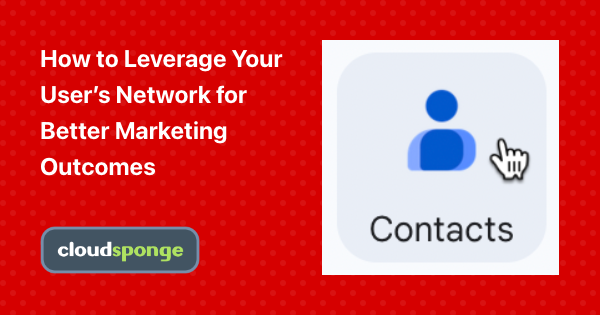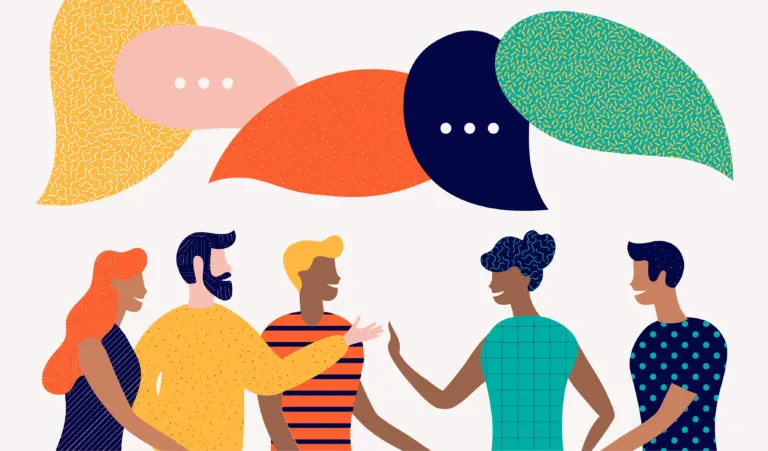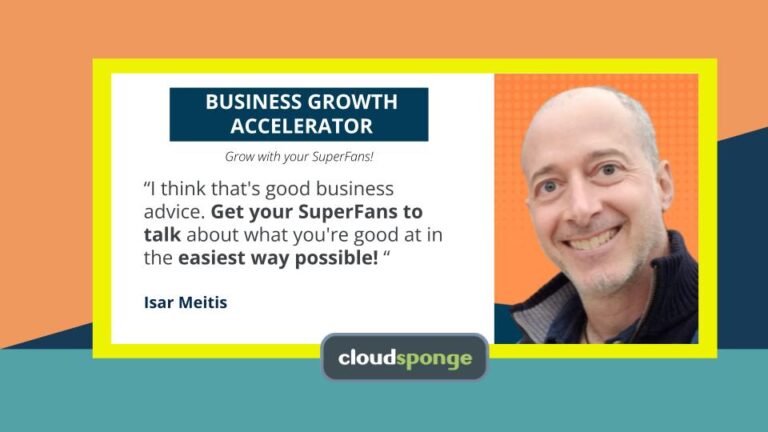Claus Lauter, the host of Ecommerce Coffee Break podcast in conversation with our CEO, Jay Gibb, explores how a contact picker can be leveraged to acquire more e-commerce acquisitions via an optimized sharing workflow, and email personalization that gets you better email open rates.
Via anecdotal evidence from CloudSponge customers such as Stitch Fix, JustFab, and many more – discover just how a single button can be game-changing for any e-commerce customer acquisition campaign.
Double the performance of your referral programs in 3 easy steps Download our DIY Workbook today
Podcast Transcript
Claus Lauter:
Hello, and welcome to another episode of the Ecommerce Coffee Break. Today, we want to talk about word-of-mouth/referral marketing. Huge potential there. A lot of companies using it. A lot of companies are not using it the right way, specifically, in times of rising ad costs, referral marketing word of mouth has a huge potential to get you the traffic that you need for your business.
So, therefore, today’s guest is Jay Gibb. He is a former software engineer and the founder and CEO of the B2B Saas company, CloudSponge, at cloudsponge.com. Together with his team, Jay has helped thousands of eCommerce store owners optimize their word of mouth since 2010. Since it was a unique blend of tech expertise and soft skills, Jay is an expert in helping eCommerce stores build the right features to reduce customer acquisition costs and increase sales. So let’s welcome to the show,
Jay. Hi, how are you today?
Jay Gibb:
Doing great. Thanks for having me, Claus.
Claus Lauter:
Jay give a little bit of a background. What got you into word-of-mouth marketing?
Jay Gibb:
You know, our customers did.
So years ago around, like you said, around 2010, we built a tool for a different purpose. Basically, what we built at CloudSponge was a whole bunch of integrations with all the different places where people store their address books. So we built an integration with Gmail contacts and Yahoo contacts, and back then it was Hotmail and Windows Live and MSN and AOL and iCloud and all that stuff, right?
Basically, all the different places where people store their contacts, we built an integration for it. And then we built an interface, basically, what’s called a contact picker, and everybody’s kind of familiar with what that is. They’ve probably seen it on their phone, right? The alphabetized list of your contacts with the alphabet down the side so you can find people and search for them and stuff, right? So we built that and then people started buying it and using it.
Jay Gibb:
And then we observed over the years why people were using it, what were they doing with it on their website, right? So we built a tool without any specific use case in mind, right? We had people who were using it for all kinds of use cases, basically any situation where somebody wanted to create a recipient list. So that might be for an eCard or event invitations, right? Or an eCommerce scenario, wishlists and referral programs and sweepstakes interfaces, and other places where you could imagine you would want a user to do some sharing and you want to make it convenient, right?
And so we got into the word of mouth universe, sort of by following the demand, right? We saw what our customers were doing with this tool that we built and then we learned from them and did more of it and then marketed towards them and tried to get… Basically started to learn what the really powerful use cases were for this tool that we built. Right? Does that make sense?
Claus Lauter:
Absolutely. Yeah. A hundred percent. So what does people motivate, or what would you recommend, to use to make people recommend some kind of content product, whatever it is to their friends? What’s the trigger there?
Jay Gibb:
Yeah. It’s different for every store I think, or for every situation, it kind of depends. For example, if you’re a bride or a bride-to-be, and you just put together a registry and you need to send it to a couple of hundred wedding guests, you’re super, super motivated to do that. Right? You’re super motivated to get that done and to do it quickly and accurately and efficiently.
That’s on one end of the spectrum of like maximum motivation, right? On the other end of the spectrum would be, what you see really often because it’s so easy, but it just doesn’t work, is mail to link on a product page. People don’t click those, they don’t use them. And it doesn’t really work. Somewhere in the middle, between those two, is basically a really well-tuned referral program, right?
Jay Gibb:
Usually some combination of double-sided referral program rewards, right? Whereas, a person who’s sending a referral link to my friends, I get something in return. If they convert, I get, maybe store credit for my next purchase, for example, right? That’s one side of the double-sided reward and the other side is they get something, they get some coupon or initial reason to shop here.
Not only because they trust me and I told them that they’re going to love this product, but also because they’re getting a 10% discount or something along those lines. Right? So I think that the rewards are different for every store, depending on their price point and all kinds of other factors, right?
Jay Gibb:
But making sure that those referral programs are double-sided I think is huge. And then also considering that, and this is probably another bigger discussion, but the trigger for a reward doesn’t necessarily have to be a purchase in the store. I think a lot of people, when they think about a referral program, they immediately assume that, in order for anybody to get either of the rewards, the referred party needs to buy something. Right?
But we’ve actually seen extraordinary success with the eCommerce stores for situations where the trigger or the referred party is not necessarily buying something yet. Maybe their first trigger is subscribing to the mailing list, right? Or getting into the marketing funnel at a higher stage of the funnel than all the way down at the conversion stage.
Claus Lauter:
No, that’s a great tip and I think you’re quite on track there. Obviously, a good referral program, sort of a win-win-win situation so both sides of the referral program win and obviously the merchant wins there in a perfect world scenario. Now I understand that your solution makes it much easier to pick the contacts instead of filling out a form field on a product detail page or whatsoever.
What’s your experience, people nowadays are very conscious about their privacy and all these things, is that an issue or is that more the convenience of using a contact picker or is basically a bigger trigger there than… How was your experience on that side?
Double the performance of your referral programs in 3 easy steps Download our DIY Workbook today
Jay Gibb:
Well, it’s an optimization step. It’s not functional completely on its own. You can’t assume that a hundred percent of people are going to use it, right? Most of the time, what we see is our customers, or our leads, people before they become customers, they’ll have some kind of referral program already. Maybe, for example, if they’re on Shopify, maybe they’re using Friendbuy or Talkable or Conjured Referrals or Gather, or one of those referral program platforms to manage all their payouts and fraud and stuff, right? And they have some numbers, they have some baseline number for how many people use that thing and are comfortable typing in manually their friend’s email addresses. Right?
Jay Gibb:
And then the optimization that we can provide is, with a couple of lines of a script or an API key, right on that same interface where somebody would normally be typing an email address, you’ll get a new button that’s like, add from the address book. It’s a little address book icon, they click it, and they see a big panel of logos: Google, Yahoo, Outlook.com, or whatever, and they select the one they want.
And so the number of people that actually click that address book icon and go through that process, it might only be 5% or 7% on average as the numbers we generally see 5-7% of the people that make a referral, out of all the people that make at least one referral, maybe one out of 20 will use that address book icon because of what you’re talking about. Because of the sort of the privacy concerns or just discomfort or whatever the reason is they don’t click it. 19 out of 20 don’t click it. But the one out of 20 that does click, it will generate 50% of your total number of referrals. Right?
Jay Gibb:
Because it’s so much more convenient, because they can go and they can select everybody with a certain domain name in the company they work for and send a referral to a lot of people at once, or they can search and select everybody in their class or their family or whatever it is. Whoever it is they have in mind, super convenient to get them to select more people, right?
And so in general, you’ll see if anybody who goes to the CloudSponge cycle… See we say over and over again, double the performance of your referral program. And that’s how we get to the double number. Right? You add that little button, maybe one out of 20 people click it, but that one out of 20 people is going to actually double the number of referrals that are ultimately set by that program.
Claus Lauter:
So the solution, the contact picker that you have, does it only work on certain platforms like shop Shopify or would it work on WordPress or WooCommerce? Where can people implement this?
Jay Gibb:
Well, it started out as a generic JavaScript that worked on all kinds of sites because we have a lot of customers that don’t use one of those platforms. They’re sophisticated engineering teams that have their own platforms. So it works everywhere. But over the last two years or so, we’ve started building more convenient integrations for WooCommerce and Shopify. Most of the time through a partner, because we don’t provide the referral program platform. Right? We don’t. We’re not in that business. We have no interest in being in that business.
Jay Gibb:
And so, what we do is, we find those partners like some of the ones I just listed, like on Shopify, let’s say it’s Conjured Referrals, right? You install the Conjured Referrals Shopify app and configure it and get your referral program going and then you can, in their documentation or our documentation, you can find instructions for adding the address book button to your Conjured Referrals interface. Right?
And over on WooCommerce, the same is true for AutomateWoo’s Refer a Friend plugin, for example. Right? And so it’s possible to do it on any story. What we generally like to do is, anybody who’s interested can just ask us, and we’re happy to get on a call with somebody and sort of look at their store together and make a specific recommendation for whatever their situation is.
Claus Lauter:
Okay. So it’s quite flexible? And so it’s not really only for a few platforms, you basically will help them to get it wherever they want to have it. Is that right?
Jay Gibb:
Yeah. And we want it to be everywhere, right? So if somebody comes to us and we don’t support whatever tools they’re using, then we put it on our roadmap and we get that done. Right? It’s important for us to basically be ubiquitous. So that’s one of our overall strategies. Yeah.
Claus Lauter:
Let’s talk about pricing. How much do you charge for this kind of service?
Jay Gibb:
The basic plan that we have is $50/month. And for that, you get everything. The only thing you don’t get is the ability to style the contact picker. The branded plan right now is priced at $150 and that’s for bigger stores, that are really brand aware, brand conscious. They want to make sure they’ve got all the right fonts and colors and corner radius’ and whatever else is their signature. And they basically wanted it to look native. They want to remove all CloudSponge branding and all that kind of stuff. Right? And those types of eCommerce stores they buy what we call the branded plan, which is $150/month.
Double the performance of your referral programs in 3 easy steps Download our DIY Workbook today
Claus Lauter:
Okay. How much time should people keep in mind when they want to have this implemented? How long does it take to get it live?
Jay Gibb:
If you’re using one of our partners, it’s just a minute or two. You just sign up for CloudSponge, get the key and paste it, or paste the script with the key. Right? It’s 10 minutes, really simple. Obviously its extra work if they want to make their own style sheet and do the branding steps and so on. And then, when you grant access to your address book with services like Google, Yahoo, and Microsoft, there’s a permission window there, right? Where you have to basically say yes, I give this store permission to read my contacts. Right? Well, to get your store’s logo into that permission window, there’s an app. You basically have to apply with those companies: Google, Yahoo, and Microsoft to get API keys, right?
Jay Gibb:
It’s not technically difficult, but it takes time. You have to submit the form and follow our instructions if you’re not sure how to do that, get the keys from them, put the keys into your CloudSponge account. So once you get into that level of the configuration, it’ll take a couple hours to do those things, right? And in Google’s case, Google wants to actually manually review your application. So we’ll walk everybody through. Every single customer gets walked through the steps of how to successfully apply for those credentials from Google and we assist. We call it our concierge service and we assist to get those credentials. Right?
So again, it’s something that anybody can do. You don’t have to be a developer to do it, but it does take a little bit of time sometimes. Right? So start to finish, the whole thing with the waiting periods when you’re waiting for a review from Google, it might take a couple days, but the amount of actual effort involves is maybe an hour at most.
Claus Lauter:
Okay. Seems to be quite straightforward if you have a little bit of technical knowledge there. Where can people find more about the color pickers?
Jay Gibb:
So your audience can go to cloudsponge.com/clauslauter, and we’ll make a special page on our site there for your audience. We’ve got a free PDF that’s a self-guided audit of your store and it’s word-of-mouth sharing features. It’s just a PDF you can download and you can go through the steps and maybe get some new ideas for things you hadn’t considered for making your word of mouth better. And then we’ll link to the show and embed the show and everything there so that everybody can find everything in one place.
Claus Lauter:
Okay. I really appreciate that. I’m sure that all listeners and viewers will find some very valuable information there. Cool. That’s very insightful. I think people definitely should try it out. As you said, the conversion rate of the ones who are using it is very, very high and it should definitely be reason enough to try it out. Thanks so much, Jay, for your time and talk soon.
Jay Gibb:
Very good. Thanks Claus.
Want to improve your site's sharing performance?
Get the Better Sharing workbook now
(it's quick, easy and absolutely free!)



